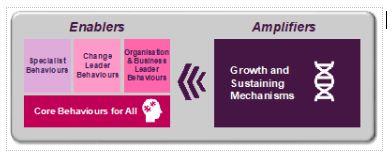We believe culture is the #1 differentiator in people and organisational performance. Which means achieving the desired outcomes for your stakeholders. Put simply, we see culture as ‘behaviour at scale’; the aggregation of how people behave and interact together. While organisations often invest significantly in developing desired behaviours, people slip back into their old ways if these new behaviours are not embedded and sustained across the organisation.
We view this as having both the enabling and amplifying elements for great performance.

Amplifying elements are the embedding and sustaining mechanisms needed to amplify the behaviours enable high performance. There are many such mechanisms, but one that we think often gets attention, but isn’t properly understood, is organisational structure. We see firms constantly reorganising in a similar way to shuffling the deck chairs on the Titanic but it’s how the organisation manifests power dynamics that’s really important and often not understood.
Nowadays, removing hierarchy and creating decentralised, autonomous smaller groups is becoming popular. But if the power dynamics don’t change, it will not make much of a difference. We see three aspects of Power: Power from within – or being individually empowered; Power With, which is the social, informal power people have in groups based on their experience and skills; and Power Over, which is the formal power that comes with a role, such as a manager.
 These power dynamics are what organisations need to focus on more than simple structure; increasing Power from Within in everyone, being honest and transparent about Power With, and reducing the ability for a few people to coerce others, e.g. minimising Power Over.
These power dynamics are what organisations need to focus on more than simple structure; increasing Power from Within in everyone, being honest and transparent about Power With, and reducing the ability for a few people to coerce others, e.g. minimising Power Over.
When these power dynamics are understood and better aligned to the desired structure to support organisational outcomes, they become an embedding, reinforcing and sustaining mechanism for the desired behaviours, and if developed across the organisation at scale, the resulting culture.
We hope that you agree just how powerful culture can be to achieve success, and in considering one important amplifying aspect of culture; power dynamics, you reflect and consider how your organisational structure and distribution of power either supports or dilutes the best possible behaviours at scale.
If you want to hear more about this, please watch this video.



